This analysis extends permuted observations to testing hypotheses βj=0,j=1,...,p for any gene. This is done by random permutation tests, which provide only approximate p-values in contrast with exact permutation tests (which are unpractical in the present case due to the large number n! of all permutations of n≈500 cases). These approximations more or less agree with the “theoretical” p-values, which are based on the hypothesis that the Studentized ˆβj follows a t-distribution on n−p degrees of freedom (see ch8.3, p371 in A.C Davison: Statistical Models):
ˆβj−βj√S2[(X⊤X)−1]jj∼tn−p,where S2 is the unbiased estimate of the error variance (based on the residual sum of squares), and X is the design matrix.
The t-distribution comes from the second order assumptions on the error ϵi and on their normality; from these the normality of the residuals ei follows. Thus normality of ei is a prerequisite for deriving p-values using the above theoretical approach. In agreement with this comparison to the model checking results, in particular the normal Q-Q plots of residuals, reveals that the two approaches to p-value calculation agree as long as the model fits the data well. Otherwise the t-distribution based approach tends to produce much lower p-values and therefore exaggerate the significance that βj≠0, as seen for several “poorly-fit” genes under the logistic model logi.S.
Click regr-coefs.csv (long format) and regr-coefs-w.csv (wide format, annotated with stars) to download the saved csv files reporting both p-values and the estimate for all regression coefficients. Click signif-gene-effects-wnlm.Q.csv, signif-gene-effects-logi.S.csv, signif-gene-effects-either.csv, or signif-gene-effects-both.csv for a gene-centric list of significant coefficient–gene associations mediating various biological effects, where each list corresponds to a rule of aggregation of p-values across the wnlm.Q and logi.S model types. For the corresponding coefficient centric lists see signif-effect-genes-wnlm.Q.csv, signif-effect-genes-logi.S.csv, signif-effect-genes-either.csv, or signif-effect-genes-both.csv.
Preparations
## Loading required package: RColorBrewer
##
## Attaching package: 'latticeExtra'
## The following object is masked from 'package:ggplot2':
##
## layer
Load functions
source("~/projects/monoallelic-brain/src/import-data.R")
source("~/projects/monoallelic-brain/src/fit-glms.R")
source("~/projects/monoallelic-brain/src/graphics.R")
gene.ids <- unlist(read.csv("../../data/genes.regression.new", as.is = TRUE))
names(gene.ids) <- gene.ids
names(e.vars) <- e.vars
E <- get.predictors() # default arguments
Y <- get.readcounts(gene.ids = gene.ids, count.thrs = 0)
set.seed(1976)
perms <- data.frame(cbind(seq_len(nrow(E)), replicate(n.perm <- 1e4, sample.int(nrow(E)))))
names(perms) <- c("U", paste0("P", seq_len(n.perm)))
sel.models <- c("wnlm.Q", "logi.S")
sel.vars <- e.vars[c(1, 3, 5, 8)]
system.time(Betas <- aggregate.CI.permut2(perms = perms, gene.ids = gene.ids, e.vars = e.vars,
sel.vars = sel.vars, sel.models = sel.models,
E = E, Y = Y[gene.ids], skip.CI = TRUE))
## user system elapsed
## 18748.892 5.076 18754.811
Results
The expressions above obtain the null distribution of regression coefficients for the selected predictor(s) Age, Gender, Dx, Ancestry.1 under the selected model(s) wnlm.Q, logi.S based on 104 permutations. Each panel within a plot shows a red vertical zero line of the null hypothesis βj=0, the null distribution as probability density (solid blue line) based on the permutations, and the corresponding p-value (dotted blue line and number on the bottom).
Under wnlm.Q
beta0densityplot("Age", mtype = "wnlm.Q")


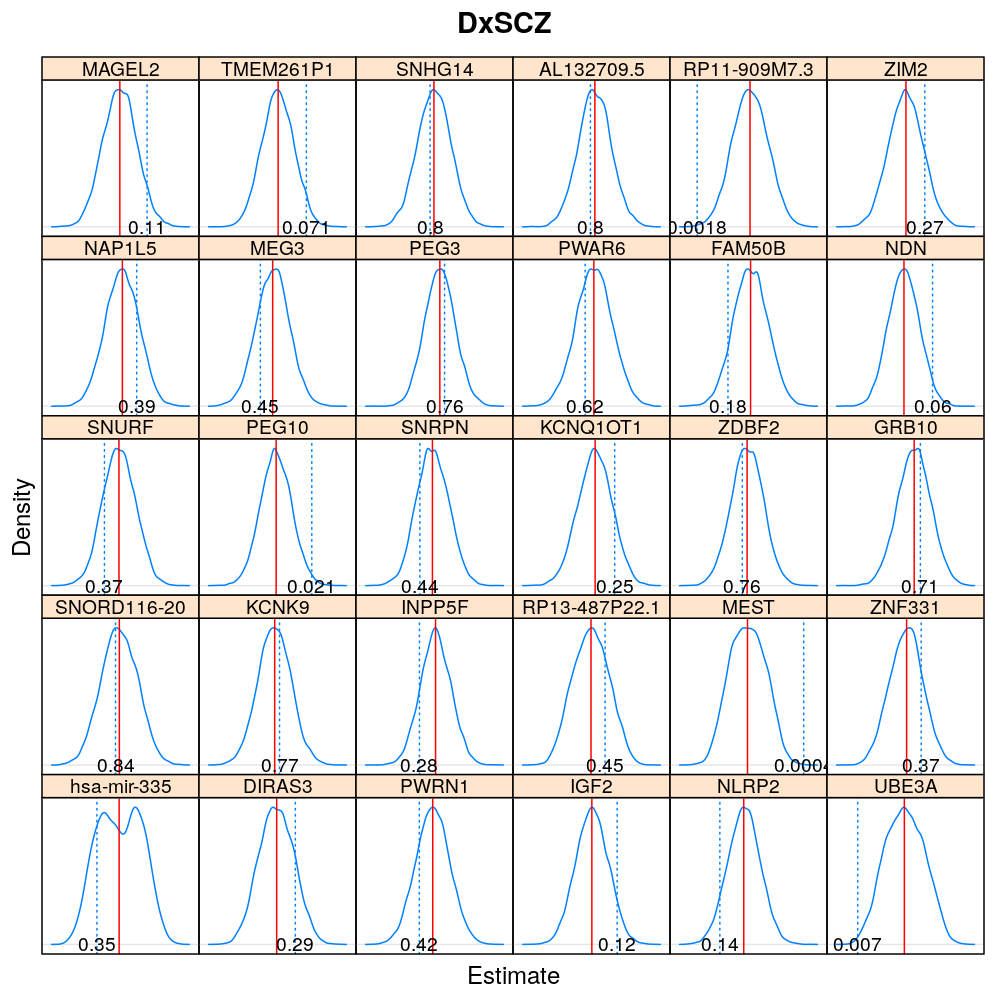
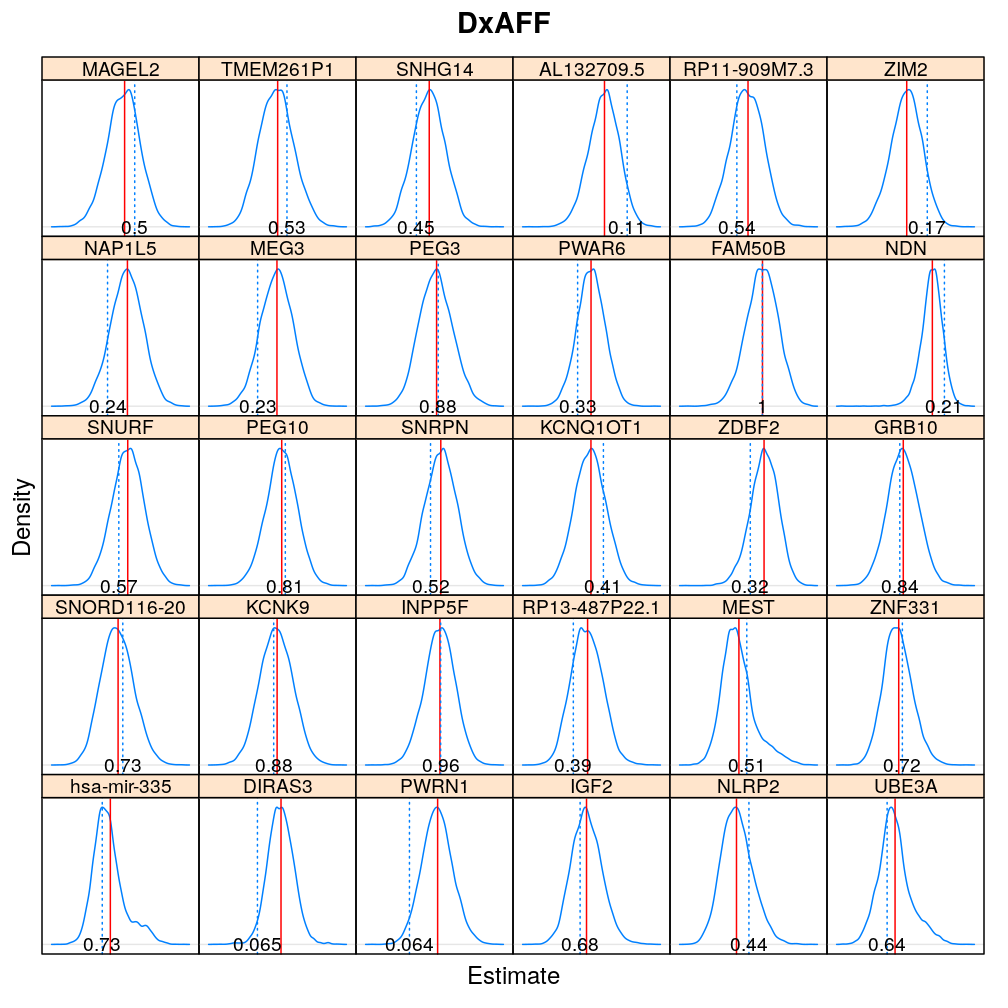
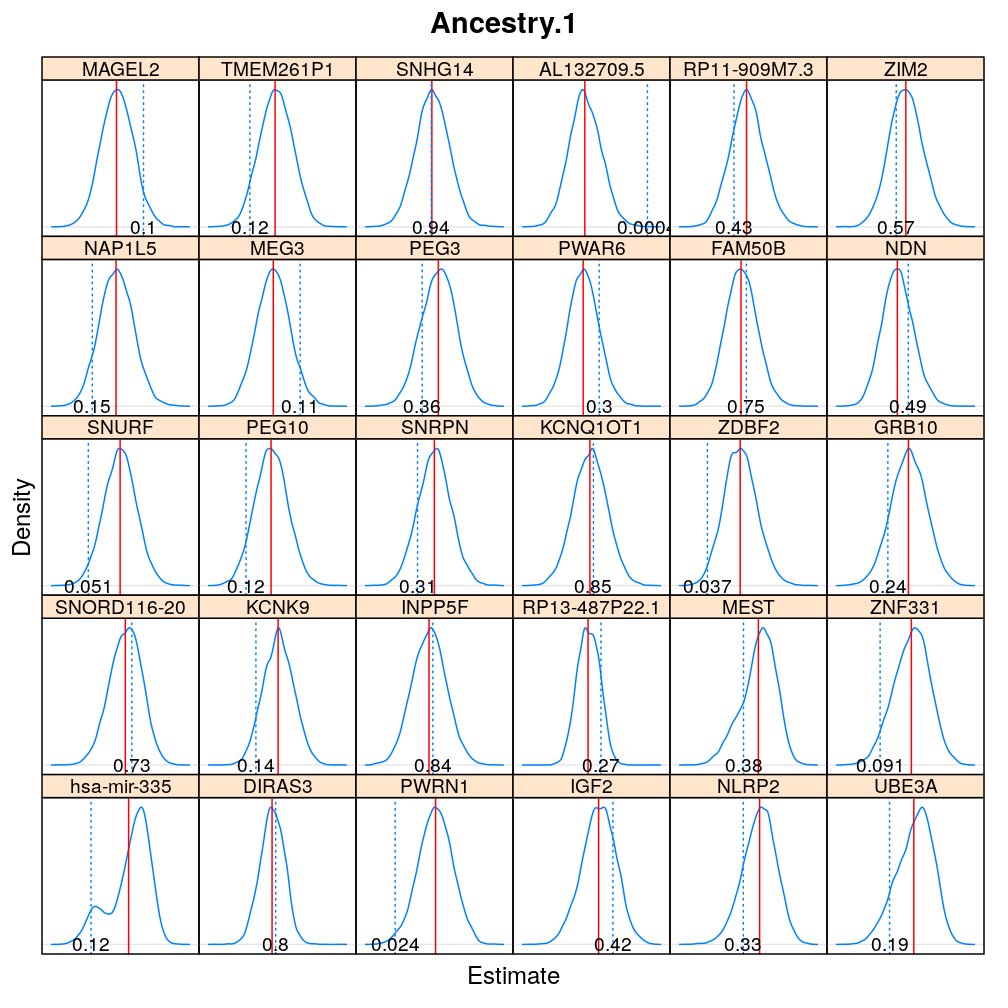
Under logi.S
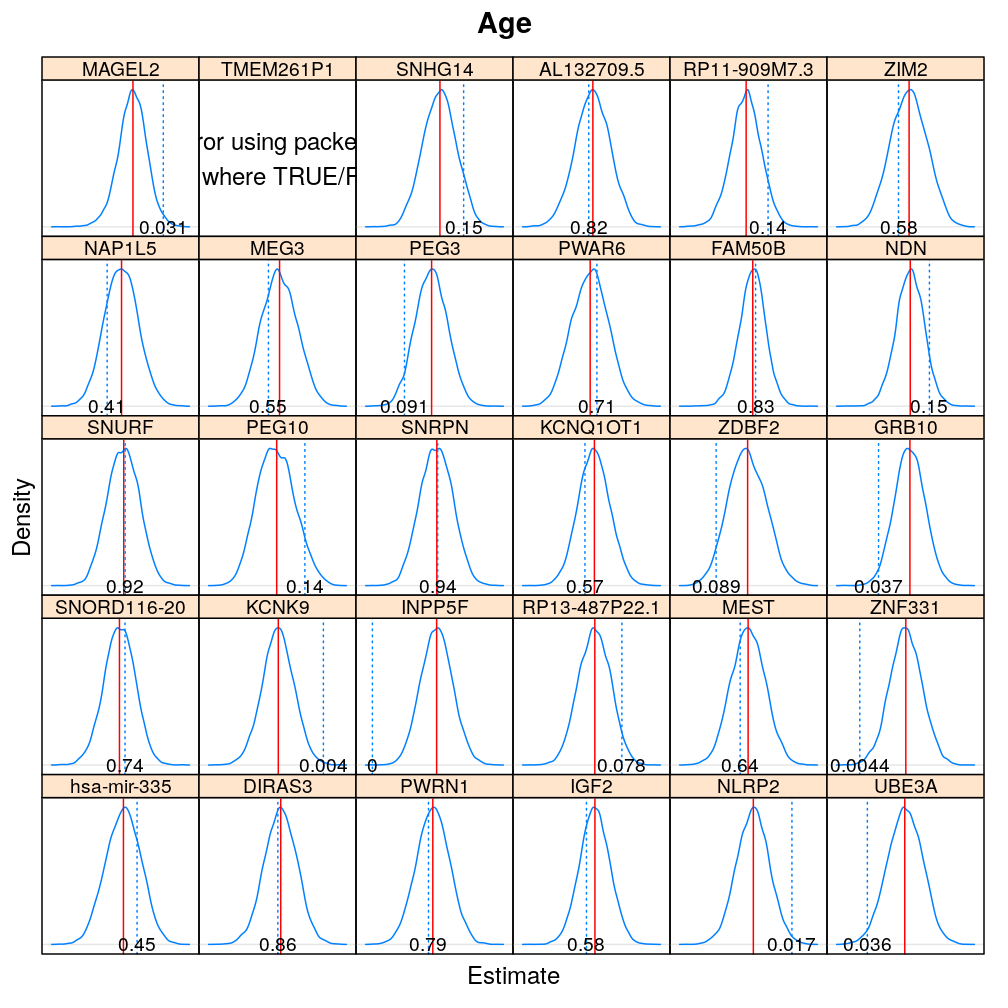


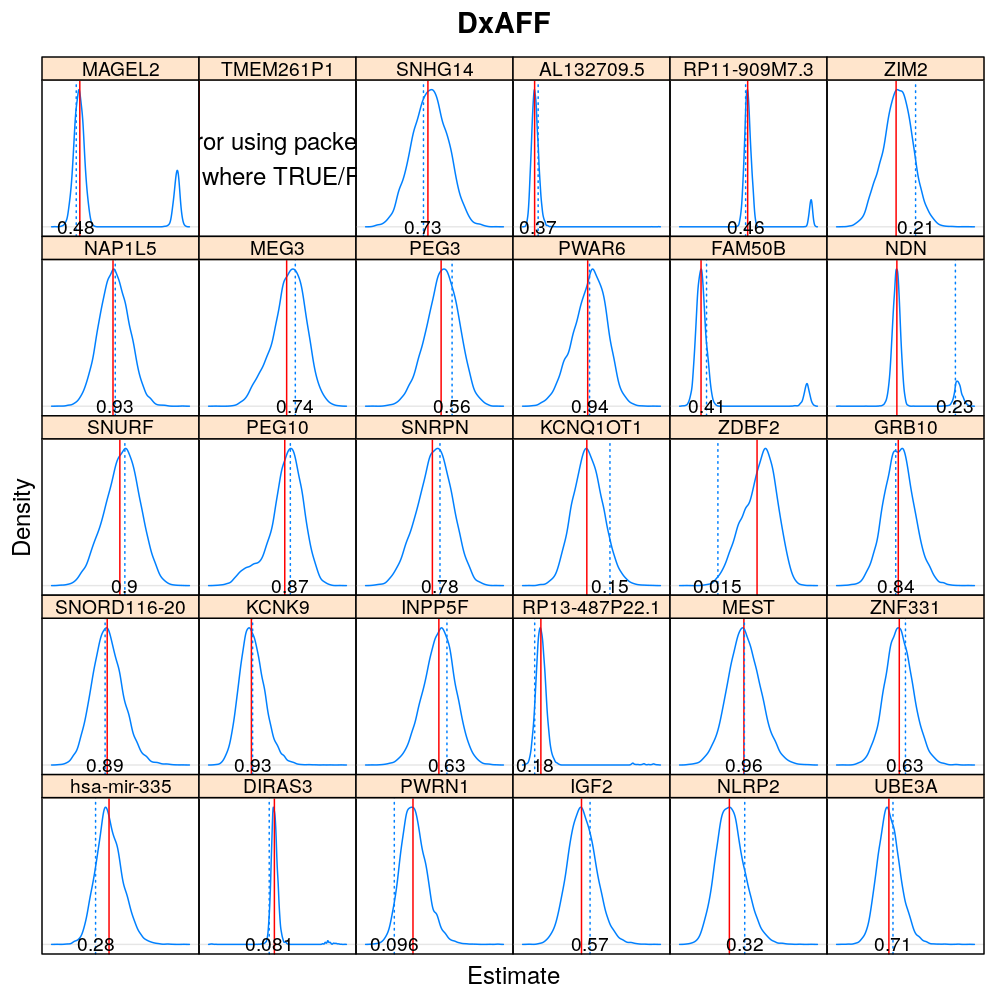

Comparison to p-values from t-distribution
The calculations and the plot below compare the p-values from the permutations to those based on the theoretical t-distribution of the statistic. Comparing these results to those from model checking reveals that the two approaches to p-value calculation agree (fall near the gray diagonal on the plots) as long as the model fits the data well. Otherwise the t-distribution based approach tends to produce much lower p-values and therefore exaggerate the significance that βj≠0.
source("2016-10-03-permutation-test.R")
M <- do.all.fits(Z = Y[gene.ids], G = E, preds = e.vars, sel.models = sel.models)
cf <- unlist(sapply(e.vars, function(e.v) predictor2coefs(M[[c(1, 1)]], e.v)))
both.p.val <-
do.call(rbind,
lapply(sel.models, function(mtype)
do.call(rbind,
lapply(cf, function(coef)
do.call(rbind,
lapply(gene.ids,
function(g) get.both.p.vals(mtype = mtype, gene = g, coef = coef, M = M, B = Betas)))))))
Adjust p-values of 0 to 10-4, which is the reciprocal of the number of permutations. Without this adjustment these p-values couldn’t be plotted on a logarithmic scale.
both.p.val[with(both.p.val, ! is.na(p.val.perm) & p.val.perm == 0), "p.val.perm"] <- 1 / n.perm
pvalplot.genes.as.panels(both.p.val, ylim = c(-1, 15))
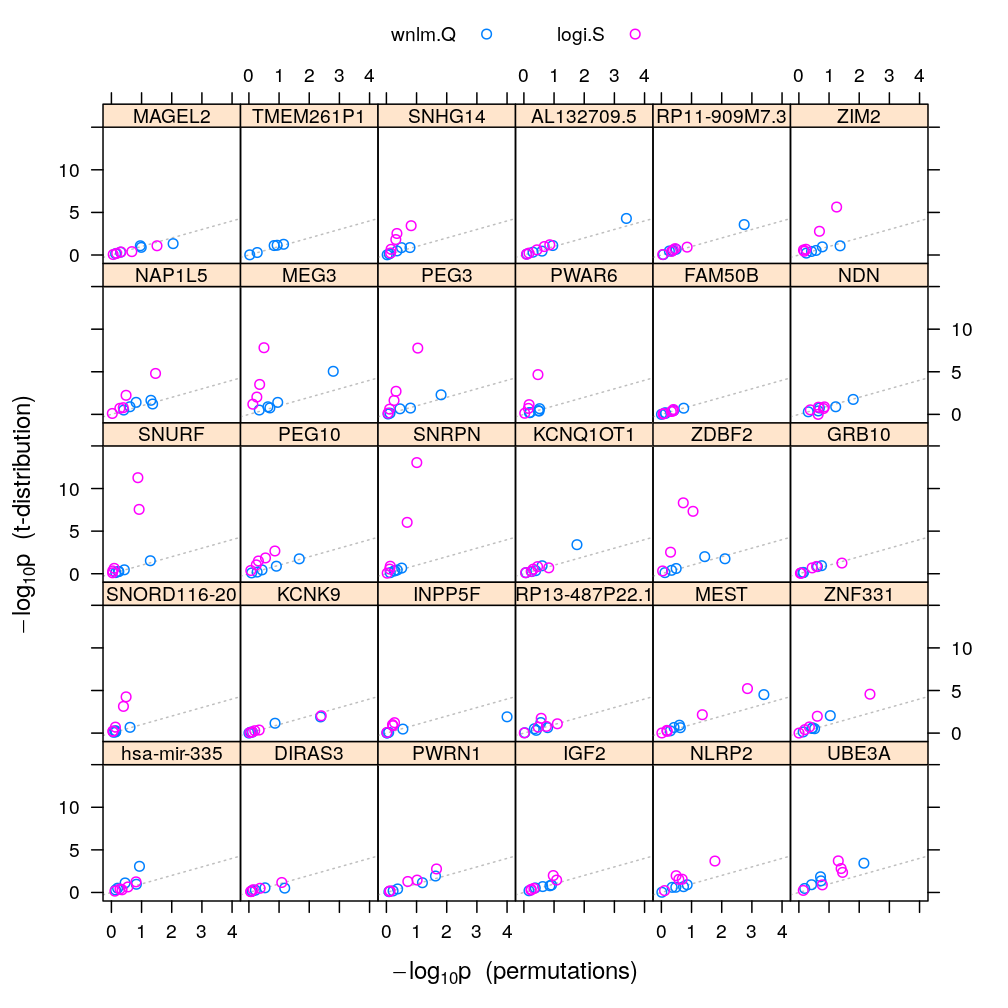
Filtering for poor fit
This filtering is based on earlier decisions on the goodness of fit of logi.S, which is stored in results/model-checking.csv.
both.p.val <- cbind(both.p.val, logi.S.OK <- read.csv("../../results/model-checking.csv", row.names = "gene")["logi.S.fit.OK"])
# set results to NA where logi.S fitted poorly
both.p.val[with(both.p.val, Model == "logi.S" & logi.S.fit.OK == FALSE), c("Estimate", "p.val.t.dist", "p.val.perm")] <- NA
Repeat the previous plot with the filtered results:
pvalplot.genes.as.panels(both.p.val, ylim = c(-1, 15))
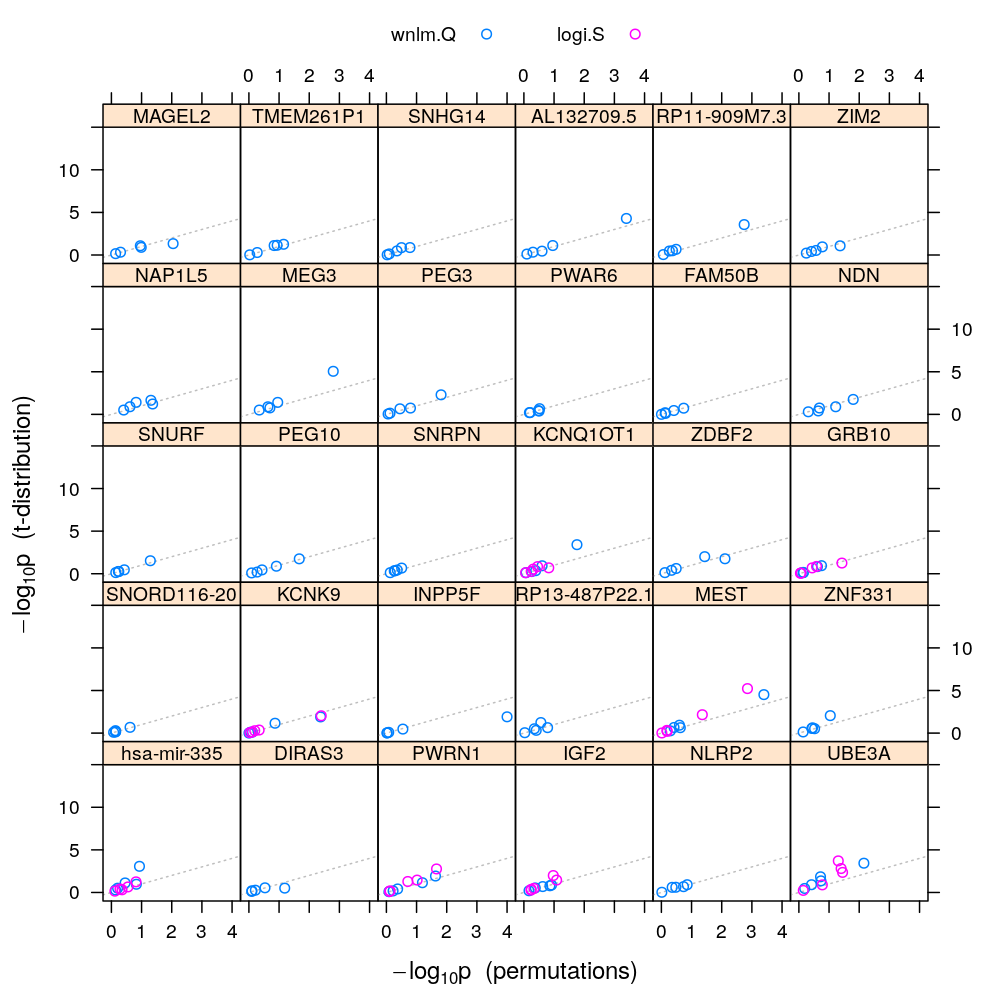
Equal x and y scaling (isometric):

Figures for manuscript
Figure for manuscript showing p-values calculated from both approaches (theory: t-distribution, and permutation test) and under both models (wnlm.Q and, when the fit was OK, also logi.S). The plotting symbols are color coded according to gene rank (rainbow, red to violet). The plotting symbols also display the rank with numbers, see the key on the top. Genes acceptably fitted by both models are distinguished with a diamond symbol and bold font from those that could be fitted only by wnlm.Q. Gray rectangle shows the decision rule, which rejects the null hypothesis if the p-value is smaller than 0.05 given both the t-distribution and the permutation-based test.
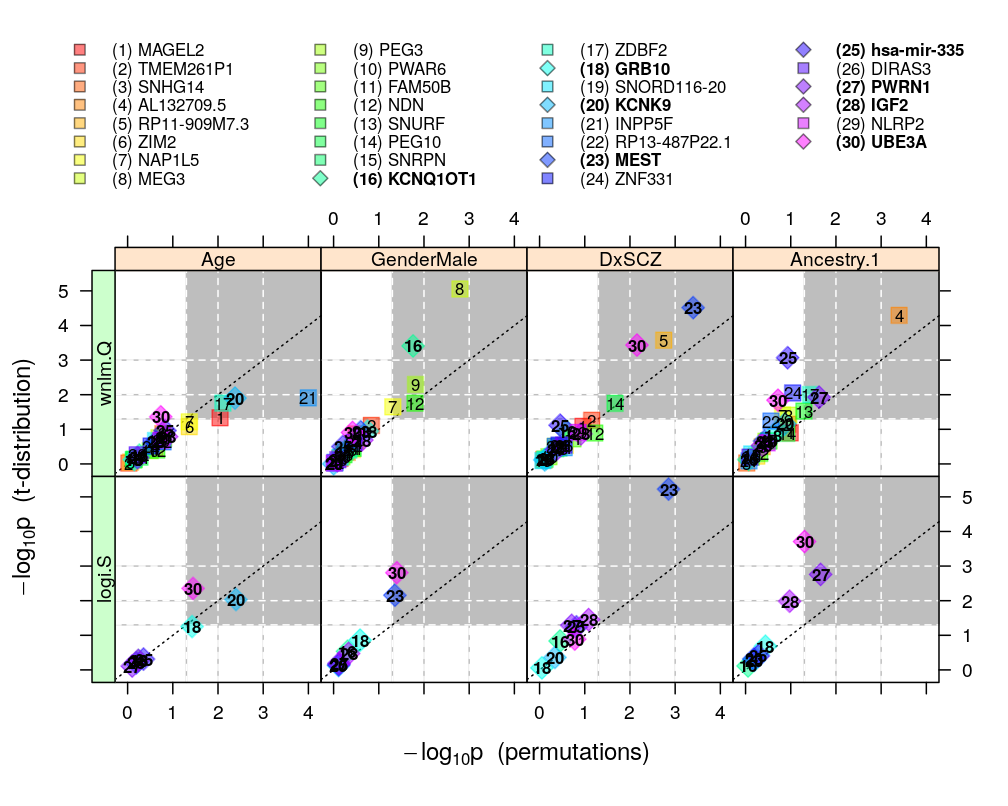
Leave logi.S out and show results only under wnlm.Q:
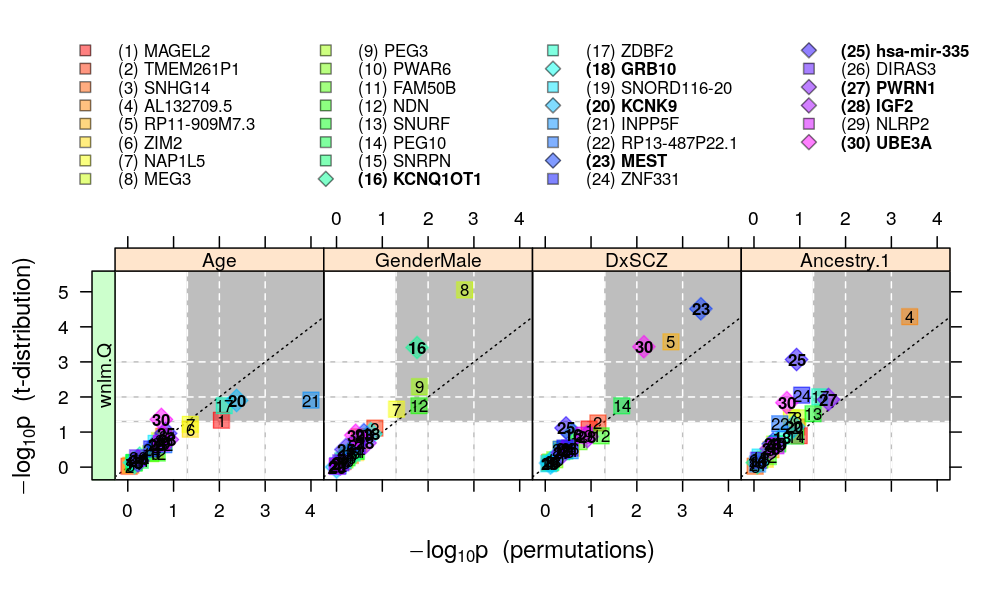
Summarizing results
Bringing results to long format and annotating significance with stars
v.names <- c("Estimate", "p.val.t.dist", "p.val.perm")
mtypes <- c("wnlm.Q", "logi.S")
varying <- lapply(c(v.names), function(v) sapply(mtypes, function(m) paste0(v, ".", m)))
both.p.val.w <-
reshape(both.p.val, direction = "wide", varying = varying, v.names = v.names,
timevar = "Model", times = mtypes, idvar = c("Gene", "Coefficient"))
stars <- data.frame(sapply(varying.p <- unlist(varying[-1])[c(1, 3, 2, 4)],
function(v) annotate.signif(both.p.val.w[[v]])))
names(stars) <- paste0(varying.p, ".*")
both.p.val.w <- cbind(both.p.val.w[2:1], stars, both.p.val.w[-1 * 2:1])
Aggregation
Aggregating significant findings over all four combinations of p-value calculation methods v∈{t.dist,perm} and model types y∈{wnlm.Q,logi.S} using the following rules
- under a given model type y take parameter–gene pairs (j,g)∣y for which pt.dist,yjg<0.05ANDpperm,ygj<0.05
- take (j,g) if in the previous step
- either (j,g)∣wnlm.Q or (j,g)∣logi.S was taken
- both (j,g)∣wnlm.Q and (j,g)∣logi.S were taken
This means that we have the rules either and both, which correspond to a less and more stringent condition, respectively. These result in two corresponding sets of pairs, {(j,g)∣either}⊇{(j,g)∣both}. (We also have the rules wnlm.Q and logi.S, which do not use aggregation over model types, and cannot be ordered in terms of stringency. Also, and in general).
The following code implements these rules.
is.signif <-
list(wnlm.Q =
with(both.p.val.w, p.val.t.dist.wnlm.Q < 5e-2 & p.val.perm.wnlm.Q < 5e-2 &
Coefficient %in% c("Age", "GenderMale", "Ancestry.1", "DxSCZ")),
logi.S =
with(both.p.val.w, logi.S.fit.OK & p.val.t.dist.logi.S < 5e-2 & p.val.perm.logi.S < 5e-2 &
Coefficient %in% c("Age", "GenderMale", "Ancestry.1", "DxSCZ")))
is.signif$either <- with(is.signif, wnlm.Q | logi.S)
is.signif$both <- with(is.signif, wnlm.Q & logi.S)
The pairs (where ) can be presented in two sensible ways: a gene-centric and a coefficient-centric way.
The gene-centric way lists, for each gene, all the significantly associated coefficients:
signif.gene.effects <-
lapply(is.signif,
function(s)
sapply(split(x <- both.p.val.w[s, c("Gene", "Coefficient")][ with(both.p.val.w[is.signif$either, ], order(Gene, Coefficient)), ], x$Gene, drop = TRUE),
function(g) toString(g$Coefficient)))
signif.gene.effects
## $wnlm.Q
## MAGEL2 AL132709.5 RP11-909M7.3 NAP1L5
## "Age" "Ancestry.1" "DxSCZ" "GenderMale"
## MEG3 PEG3 NDN PEG10
## "GenderMale" "GenderMale" "GenderMale" "DxSCZ"
## KCNQ1OT1 ZDBF2 KCNK9 INPP5F
## "GenderMale" "Age, Ancestry.1" "Age" "Age"
## MEST PWRN1 UBE3A
## "DxSCZ" "Ancestry.1" "DxSCZ"
##
## $logi.S
## KCNK9 MEST
## "Age" "GenderMale, DxSCZ"
## PWRN1 UBE3A
## "Ancestry.1" "Ancestry.1, Age, GenderMale"
##
## $either
## MAGEL2 AL132709.5
## "Age" "Ancestry.1"
## RP11-909M7.3 NAP1L5
## "DxSCZ" "GenderMale"
## MEG3 PEG3
## "GenderMale" "GenderMale"
## NDN PEG10
## "GenderMale" "DxSCZ"
## KCNQ1OT1 ZDBF2
## "GenderMale" "Age, Ancestry.1"
## KCNK9 INPP5F
## "Age" "Age"
## MEST PWRN1
## "GenderMale, DxSCZ" "Ancestry.1"
## UBE3A
## "Age, GenderMale, DxSCZ, Ancestry.1"
##
## $both
## KCNK9 MEST PWRN1
## "Age" "DxSCZ" "Ancestry.1"
The coefficient-centric way lists, for each coefficient, all the significantly associated genes:
signif.effect.genes <-
lapply(is.signif,
function(s)
sapply(split(x <- both.p.val.w[s, c("Gene", "Coefficient")][ with(both.p.val.w[is.signif$either, ], order(Coefficient, Gene)), ], x$Coefficient, drop = TRUE),
function(g) toString(g$Gene)))
signif.effect.genes
## $wnlm.Q
## Age GenderMale
## "MAGEL2, ZDBF2, KCNK9, INPP5F" "NAP1L5, MEG3, PEG3, NDN, KCNQ1OT1"
## DxSCZ Ancestry.1
## "RP11-909M7.3, PEG10, MEST, UBE3A" "AL132709.5, ZDBF2, PWRN1"
##
## $logi.S
## Age GenderMale DxSCZ Ancestry.1
## "KCNK9, UBE3A" "MEST, UBE3A" "MEST" "PWRN1, UBE3A"
##
## $either
## Age
## "MAGEL2, ZDBF2, KCNK9, INPP5F, UBE3A"
## GenderMale
## "NAP1L5, MEG3, PEG3, NDN, KCNQ1OT1, MEST, UBE3A"
## DxSCZ
## "RP11-909M7.3, PEG10, MEST, UBE3A"
## Ancestry.1
## "AL132709.5, ZDBF2, PWRN1, UBE3A"
##
## $both
## Age DxSCZ Ancestry.1
## "KCNK9" "MEST" "PWRN1"
Writing results to files
write.csv(both.p.val, "../../results/regr-coefs.csv", row.names = FALSE)
write.csv(both.p.val.w, "../../results/regr-coefs-w.csv", row.names = FALSE)
invisible(lapply(names(signif.gene.effects),
function(x) write.csv(data.frame(Gene = names(y <- signif.gene.effects[[x]]), Coefficient = y), file = paste0("../../results/signif-gene-effects-", x, ".csv"), row.names = FALSE)))
invisible(lapply(names(signif.effect.genes),
function(x) write.csv(data.frame(Gene = names(y <- signif.effect.genes[[x]]), Coefficient = y), file = paste0("../../results/signif-effect-genes-", x, ".csv"), row.names = FALSE)))